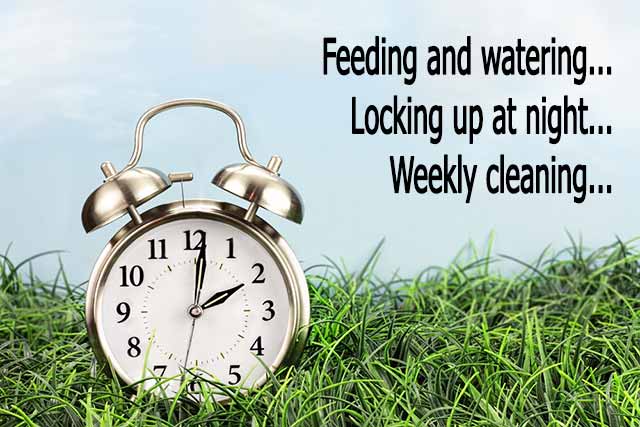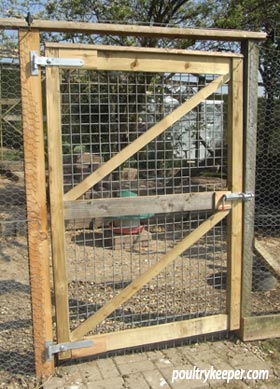Keeping a few chickens in the back yard really is quite straight forward; however there are some things to consider in order to get the right sort of birds for your situation and to keep them in the best possible health to get the most enjoyment out of keeping them.
This page hopes to get you thinking about the types of chickens and their requirements.
Choosing a breed
There are quite literally hundreds of different breeds of chicken to choose from and out of these, many have slightly different requirements.
Some breeds of chicken come only as Large Fowl, and others are also available as Bantams which are a smaller version that look the same. The Orpington for example is available in both large and bantam sizes but the Cochin is only available as large fowl.
There are a handful of ‘True Bantams’ where there is no large fowl equivalent. Examples of these are Dutch Bantams, Japanese Bantams and the popular Pekin Bantam.
Bantams tend to be quite flighty whereas the heavy breeds of large fowl often cannot fly more than a few inches off the ground. Orpingtons for example won’t usually roost very high due to their huge size and will usually just huddle on the floor of the coop.
Every breed is slightly different in the amount of eggs they lay. Typically hens that have been bred for exhibition purposes do not lay as well as utility hens. Bantams of course lay smaller eggs which some people say they prefer for taste.
Hybrids
 Hybrids are chickens that have been created by crossing pure breeds. They are typically crossed to make good layers (the hybrid to the right can lay 280 to 300 eggs!), coloured eggs or attractive hens. Some can be very attractive and they are all generally very hardy. Hybrids are produced in larger numbers that pure breeds and most of the crosses used make the males a different colour as day old chicks so that only females can be raised, therefore reducing costs by about half. A typical hybrid hen will cost you around £15 compare to £25 to £30 for a typical pure breed hen.
Hybrids are chickens that have been created by crossing pure breeds. They are typically crossed to make good layers (the hybrid to the right can lay 280 to 300 eggs!), coloured eggs or attractive hens. Some can be very attractive and they are all generally very hardy. Hybrids are produced in larger numbers that pure breeds and most of the crosses used make the males a different colour as day old chicks so that only females can be raised, therefore reducing costs by about half. A typical hybrid hen will cost you around £15 compare to £25 to £30 for a typical pure breed hen.
Hybrids are a good choice if eggs are one of your priorities although if you think you might like to hatch some eggs, remember hybrid hens do not breed true – you would need the original pure breeds to cross again in order to create more of the same thing so whilst you can hatch their eggs, you may want to consider a few pure breeds for this purpose or consider buying in eggs to hatch.
Free Range
You will of course need a chicken coop but also a secure run or area that is predator proof. A question that people always ask me is “How big should their run be?” I always say “as big as possible within reason.” Even 2 chickens kept in a 2 meter run will soon turn it to mud and get bored (which can introduce vices such as feather pecking and egg eating) but I always believe that it’s fine to provide a small run like this if you can let them out for a few hours each day to free range while you are around. This will give them a chance to forage, supplement their diet and reduce boredom.
Once chickens have settled into their new house, they will go back to it to roost every night so you can let them out in the late afternoon, knowing they will come back to roost at night keeping everyone happy! Some houses and runs have handles or wheels that make them easy to move onto fresh ground which is not only good to prevent a build up of worm eggs and disease but also provides them with a little fresh grass to graze.
Keeping Chickens in the Garden
If you have a ‘nice’ garden that you don’t want spoilt, it’s usually a sensible idea to limit their foraging. Chickens scratch at the ground, make dust baths in the dry soil, leave muck wherever they go and destroy tender young plants. If you can plant in pots, this will help and fencing off part of the garden is usually a good choice to keep them out if you have tender or precious plants. Chickens with feathered feet scratch less and bantams can clear a 6 foot fence if they want to. Heavy breeds of large fowl can be kept out with a knee high fence or box hedge. If you want to stop a bird from flying then you can clip one wing (not both).
So you have decided on the breed that’s right for you and your circumstances. Next, you will need to think about keeping them secure from predators in a suitable chicken house and chicken run – click on a link to go to that page!








hi, i have four bantams and most of my fences in the garden are 6 foot but there is a section of 3 foot, if i clip one wing will they not be able to clear it? it might be four foot but its low and they have a dog next door…
thanks
penny
Maybe… it’s too hard to say. Bantams can usually fly reasonably well so I would test the theory first when the dog isn’t around.
Hi! I have 4 bantams 3 girls and a boy which I raised from 3 weeks old and are now 19weeks. My boy has now become aggressive and is attacking my dog but more upsetting he is attacking my children (2&4 years old) and has scratched my youngest face and neck simply because he went to pet one of the girls an other times there has been no other reason just they are playing in the garden. he is fine with adults. Is there anything I can do to stop this or is he a lost cause? I don’t want to have him put down but cocks are difficult to regime as you are most probably aware. I just don’t know what to do for the best. Thanks.
Hi Catherine,
Sadly there is nothing you can do. Aggression is a funny thing, his brother could be fine for example but once he starts this, there is no stopping him and the priority is to have confidence that he will not harm your children.
A cock can cause a lot of damage to a child, please don’t take the risk of keeping him.
To be honest, it’s best not to reproduce from him (or you are breeding in that aggression to future generations) so I would say have him put to sleep.
I’m sorry for the bad news 🙁
Hi I am planning on keeping 4 or 5 chickens at the bottom of my garden which is rather over grown with vines stones and such (previouse tenant never touched the garden in 20 years) I have cleared a lot of it but there is a section overlooked by trees plum and apple not much grass are there any plants and such not good for chickens
I don’t cover poisonous plants on this site (poultrykeeper.com has a good page on this, listing them) but I’ve never had any problems. Chickens tend to know what they should or should not eat.
Hi
How much space does each chicken need ?
Please see my pages on housing and runs. Ideally as much as you can give.
Hi. I bought 3 chickens from a cattle market this week, I am completely new to this. Turns out the one is a cockerel! What to do ??? Is one cockerel with just 2 hens abit mean? Surely we cant eat the eggs? Do I need to get more chickens if the cockerel is staying?
Its only the fourth day that it is obvious, he is at the one chicken most of the time ans very vocal.
please any advice
Breeders often sell birds in trios – a male and two females. It is fine to keep them together but during the spring and summer, it is likely that the hens will lose feathers on their backs and sides and his spurs and feet may break the skin from his constant attention. You should invest in a couple of poultry saddles to help protect their backs (Orpingtons UK sell them) and inspect them regularly.
If they do lose their feathers, you should remove the male to give them a rest. Alternatively you can add more females but I would wait and see how you get on with these first.